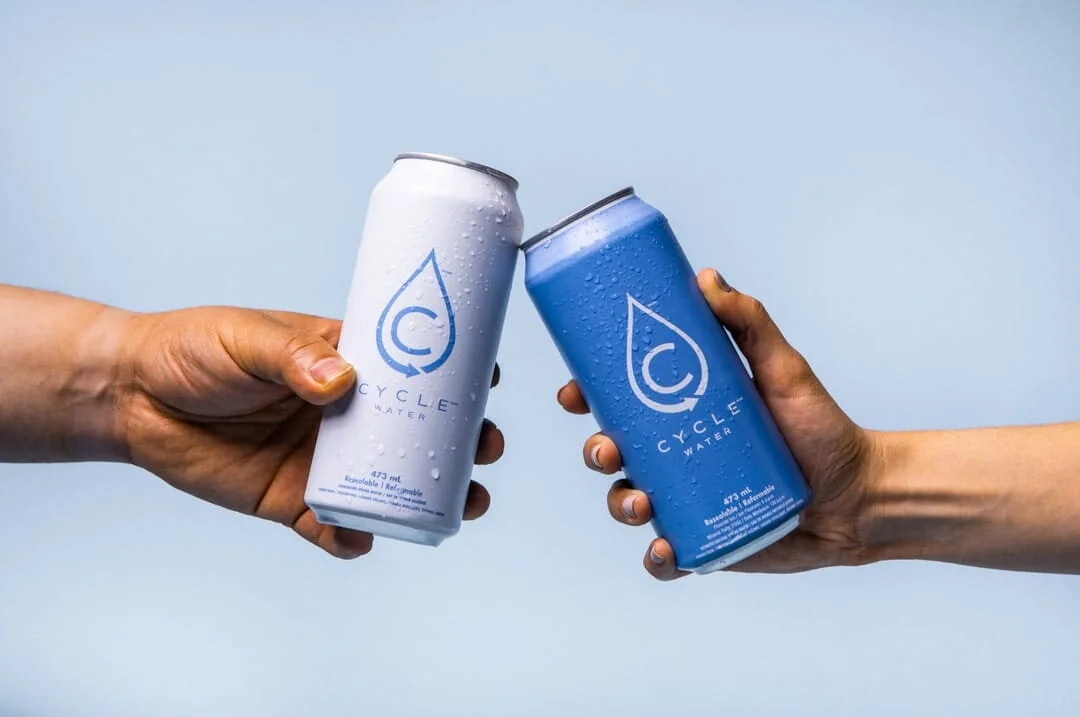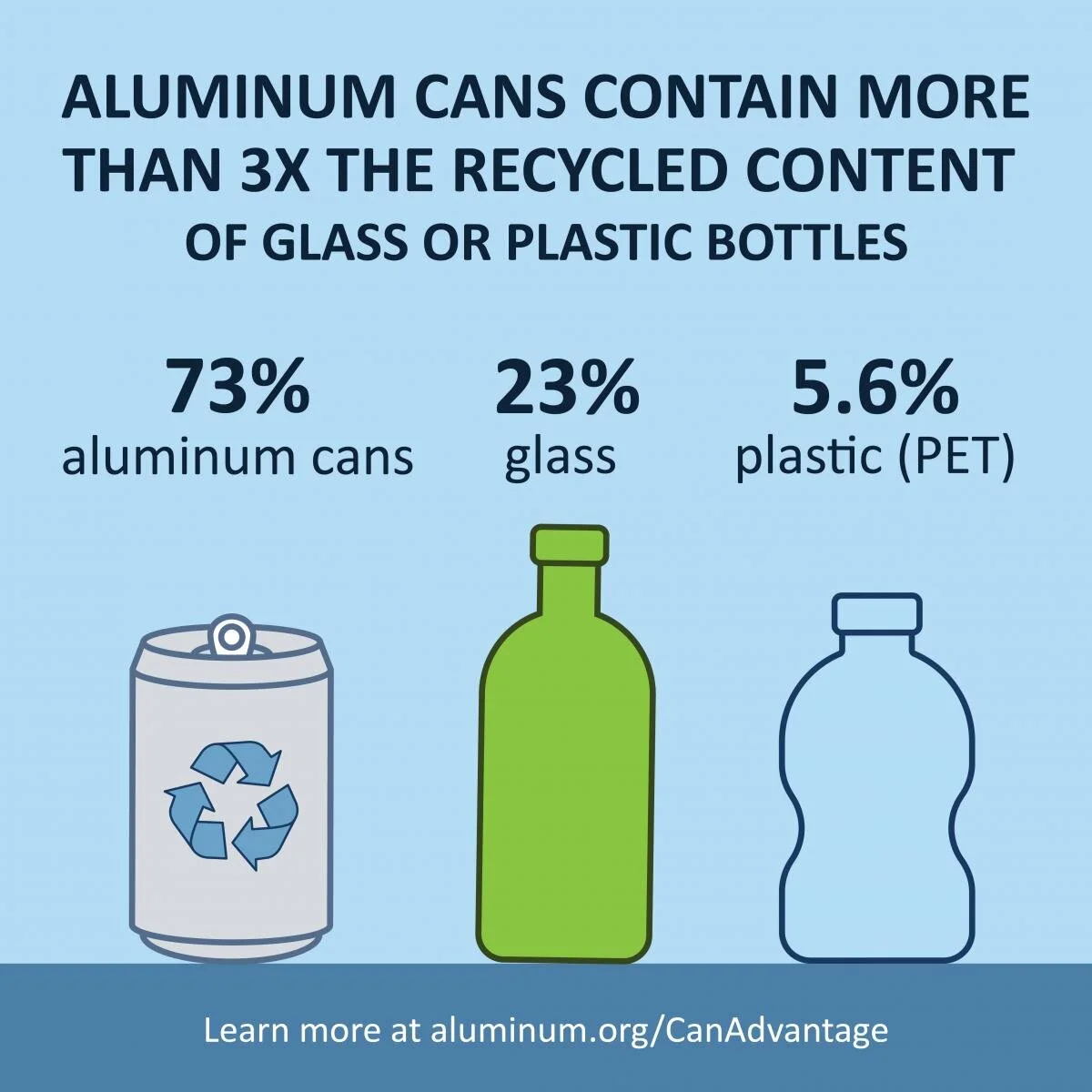Aluminum Canned Water > Plastic Bottled Water
With the end of #PlasticFreeJuly insight, we thought it would be appropriate to shine a spotlight on Cycle Water - a Canadian brand that exemplifies the transition away from plastics, towards alternative materials for its products (in this case, Aluminum). Grabbing a plastic bottle of water on the go currently has a small stigma attached to it (you should BYOWater), but sometimes you get caught without water when you are desperately in need of it.
A recent visit to Whistler, British Columbia highlighted this desperate need for water, coupled with a lack of accessible water refill stations. In the summer months, people head to Whistler to be outdoors and active. With much of Western North America being affected by extreme heat waves in 2021 - this can be a deadly combination requiring hydration. Much of the local population are familiar with, and remember to BYOW, but it is the many tourists (1.65 million in the summer months) who find themselves searching for that $3 bottle of water. Cycle Water offers an alternative way to stay hydrated while also helping you avoid contributing to our poor national recycling rate (only 9% of plastics are recycled).
Cycle Water’s identification of the problem at hand makes it a leader in the space. Read on to see what we learnt from our interview with co-founder Matthew Marrone.
~
What made you want to start Cycle?
It all started in 2017 when Matthew took a trip to Morocco in the Sahara Desert. With no natural sources of water for miles around, plastic water bottles are a common accessory. It makes sense; plastic serves a vital purpose in environments like this. Matthew's aha moment took place when he noticed these empty plastic bottles littered in the ancient sand dunes. Plastic always finds a way to make an appearance. Following this initial lightbulb, Matthew had another one with his co-founder Ryan Kucan, this time in Japan. Over a couple of beers in a nondescript local bar, the two reflected on a mutual observation: how the Japanese were leveraging aluminum for many products, coupled with Japan's efficient recycling techniques/infrastructure. They identified how Canada was still very reliant on other types of materials.
Combining the two travel aha moments, the duo saw a market opening: introduce aluminum packaged water in Canada. After doing some testing, they found that there was the potential for strong market adoption. With this good news came the bad: consumers are being deceived. Ever since recycling programs began to be introduced in the 1980s, we, as consumers, have been told that if an item is branded with the recycling logo, it will be recycled. However, a 2019 study revealed that only 9% of plastics are recycled. Consumers are slowly becoming more aware of the problem, but the plastics veil has yet to be lifted and consumer education is required.
In 2018, a global event brought the plastics problem a lot closer to home: China, the country accepting about 45% of the world's garbage, closed its border to waste imports. At this time Canada was exporting over 50% of its recycling to China; this closure meant that half of Canada's recycling had nowhere to go but into our system (waste and eco alike), or to other developing countries (Malaysia, Thailand, Taiwan). As a result of exporting our waste for so many years, Canada's national recycling infrastructure has suffered: you can find outdated and disparate recycling technologies aplenty. Rather than focus on reducing plastic and building infrastructure, no one is taking accountability.
Rather than be frustrated by the problem, the co-founders decided to be a part of the solution. If consumer trends are leaning toward packaged water - find a viable solution with aluminum - a convenient, familiar solution to a common problem. However, a disclaimer should be made that the founders recognize the fact that if you have access to tap water access, first and foremost, use a refillable bottle. Canada is blessed with 20% of all freshwater on the planet. Using Japan as an inspiration, Cycle Water hopes that with more knowledge, process, and alternate material solutions, Canadians will make more informed choices.
What's the most innovative thing about your product?
The simplicity of aluminum packaging. Simplicity is, in and of itself, innovative. You're already familiar with the aluminum can - Cycle Water leverages an old system for a new product.
**Greenvine note: Aluminum aside, we found the company's resealable can to be very innovative. Check it out here. Cycle Water was the first canned water in North America to introduce this feature.
Tell us about aluminum.
Aluminum has many benefits. First, aluminum is lightweight, which keeps shipping costs down. Second, aluminum requires less energy to cool and maintains shelf stability, keeping your energy bill in check. Third, aluminum is infinitely recyclable - whereas plastic cannot be recycled even once without degrading in quality. This means that aluminum can maintain its structural properties and strength throughout infinite passes through the recycling system. Today, about 75 percent of all aluminum produced in history, nearly a billion tons, is still in use. Conversely, we have thrown out over 6 billion tons of plastic since mass production began in the 1950s.
Aluminum is an abundant earth element, about 8% of the Earth's crust - outranked only by oxygen (46.1%) and silicon (28.2%). Once mined, the production and recycling phases are incredibly effective. However, Matthew elaborates, "Given its more intensive mining phase, we need to make sure we are doing it responsibly, in Canada's backyard, where "we" (our governments, indigenous groups and society as a whole) are setting the rules." Alternatively, carbon offsets are always available - there are many ways to manage your company's carbon footprint.
Who is your target consumer?
It is really for everyone, from the active, the adventure seekers, to the corporate office manager, to the moms/dads on a road trip. Having a case of Cycle Water beats the plastic bottle. Many of Cycle Water's customers are mid-way on their journey to sustainability. These customers recognize the damages of plastic bottles but don't continuously remember to bring/fill their reusable bottles.
What is your positive environmental impact?
Beyond the company's innovative material selection and its important recyclability characteristics, the company gives back to the community it takes from. Cycle Water gives a significant portion (10¢ of every can sold) to Plastic Oceans Canada. This partnership helps to facilitate shoreline clean-ups, education, and outreach. Cycle Water sees this charitable component of the business as a pivotal role in the clean-up caused by other companies. The company is happy to support the community it works in, including hospital front line workers in the pandemic and Greenvine's next beach clean-up ;)
"Behind every brand is human beings," Matthew reminds me.
What has consumer demand been like?
The demand for Cycle Water has been mixed. Its B2B channels have seen very strong traction. Retailers are becoming more aware of the plastic burden being placed on consumers. As a result, retailers are purchasing the company's product to reduce plastic onsite and to be able to offer plastic-free alternatives. Primarily, Matthew cites a lack of awareness around the benefits of aluminum as a reason for mixed demand: "Some people are further along in their sustainability journey." He wants to become the go-to water choice for water on the go.
Where do you see the industry heading?
Matthew only sees the space continuing to grow. Both companies and consumers are putting money into the space. People are looking for health-conscious alternatives and socially aware brands. As awareness grows for Environmental, Social, and Governance (ESG) factors, demand for brands like Cycle Water will only increase.
What is the biggest challenge Cycle Water faces?
Matthew cites two challenges the company is working on:
They are developing consumer education targeted at consumers who are not convinced of the value of sustainable options. There is a lot of information available to the public regarding sustainability, and not everyone is convinced. Using the right platforms and more concise language directed at the brand's offering is a starting point. Consumers choose to become educated.
They are communicating to the retailers/vendors that customers want sustainable products, and that Cycle Water is a good alternative to traditional options.
Where are your products available?
Cycle Water, both carbonated and still varieties, are available in many restaurants in Toronto, through national retailers, including ALL Loblaws & Fortinos, and of course, available online, direct from the source. More on the way in the coming months.
What's next for Cycle Water?
Cycle plans to continue to expand its capacity & distribution. In addition, Cycle Water will be looking to increase its retail footprint and engage with the local community. Once Covid-19 allows it, Cycle hopes to sponsor events and music festivals - engaging in different activations.


